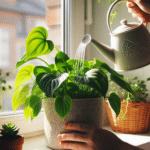You’ve carefully nurtured your geraniums, hoping for vibrant blooms and lush greenery. Yet, you’re met with leaves turning an alarming shade of yellow.
This common issue can leave even the most seasoned gardeners puzzled and concerned. But fear not, understanding the root cause is the first step towards restoring your plant’s health.
Yellowing leaves in geraniums are more than just an aesthetic issue; they’re a cry for help, signaling that something’s amiss in their environment or care routine. Whether it’s a watering mishap, nutrient deficiency, or an underlying disease, pinpointing the exact cause is crucial.
In this article, we’ll guide you through the potential reasons behind this disheartening change and offer practical solutions to revive your geraniums. Let’s embark on this journey to greenery together, transforming those yellow leaves back to their rightful, vibrant green.
Understanding Geranium Leaves Turning Yellow

Common Causes of Yellowing Leaves
Yellowing leaves in geraniums can stem from a few key issues, each with its own set of solutions. Over-watering and under-watering are prime culprits, with the former causing roots to rot and the latter leaving your plants dehydrated.
Nutrient deficiencies, particularly a lack of nitrogen, can also lead to yellow leaves, as nitrogen is essential for chlorophyll production.
Furthermore, pests and diseases, such as bacterial leaf spot or rust, can attack your geraniums, resulting in yellowed, unhealthy foliage. Identifying the correct cause is critical for the recovery of your plants.
The Role of Environmental Factors
Environmental factors play a significant role in the health of your geraniums. Insufficient light can weaken plants, leading to pale leaves that eventually turn yellow. On the flip side, too much direct sunlight can scorch leaves, causing them to yellow and drop.
Temperature stress from sudden cold snaps or prolonged heat waves can also induce yellowing. Ensuring your geraniums are in an environment that mirrors their natural habitat as closely as possible will help keep them in peak condition.
Diagnosing the Problem
Nutrient Deficiencies and Solutions
Your geraniums turning yellow may well be shouting for help due to nutrient deficiencies. Primarily, a lack of nitrogen is the usual suspect, causing leaves to lose their vibrant green color. To combat this, incorporating a balanced, water-soluble fertilizer rich in nitrogen can turn things around.
Apply this solution every four to six weeks during the growing season, ensuring your plants get back to flaunting their lush green leaves.
Watering Issues: Over or Underwatering
Ah, water—the elixir of life, yet too much or too little can spell trouble for your geraniums. Overwatering leads to soggy soil, choking your plants and turning leaves yellow as a distress signal. On the flip side, underwatering stresses them out, causing a similar yellow makeover.
The key lies in the balance. Aim for moist, well-draining soil. A simple touch test before watering goes a long way—dip your finger into the soil; if it’s dry an inch below the surface, it’s time for a drink.
Pest Infestations and Disease
Pests and diseases could be the culprits behind the yellowing drama. Bacterial leaf spot and rust are common villains, lurking around to attack your geraniums. Keep an eye out for any unusual spots or powdery substances on the leaves.
If you spot these signs, act fast! Removing affected leaves and applying an appropriate fungicide or pesticide can help your plant recover. Remember, prevention is always better than cure, so regular checks are your best defense against these unwelcome guests.
Preventative Measures and Best Practices
Proper Watering Techniques
Achieving the right watering balance for your geraniums can feel like you’re walking a tightrope. Too much water, and you’re sending out an open invitation to root rot. Too little, and your plants get cranky, signaling their displeasure by turning their leaves yellow.
Aim for moist soil that’s never soggy. A simple finger test can guide you – if the top inch of soil feels dry, it’s time to water. Consistency is key, so invest in a schedule, and your geraniums will thank you with vibrant green leaves.
Fertilization and Soil Health
All types of Geraniums aren’t too fussy, but they do appreciate a good feed now and then. A balanced, water-soluble fertilizer delivered every four to six weeks during the growing season can do wonders.
But here’s the kicker – too much love in the form of fertilizer can harm them, leading to salt buildup and, you guessed it, yellow leaves. Ensure your soil is well-draining to keep roots happy and to prevent water from pooling.
Occasionally, introduce organic matter to keep the soil fertile and aerated. Healthy soil supports healthy growth, which translates to fewer yellow leaves.
Light and Temperature Considerations
Geraniums love the spotlight but prefer not to bake in it. Ideal conditions include plenty of indirect sunlight and a little afternoon shade to protect them from the scorching midday sun. If leaves start turning yellow and dropping, it may well be a sign they’re getting too much direct sunlight.
On the flip side, too little light can weaken your plants, making them susceptible to pests and disease. Temperature-wise, they enjoy a range between 65-75°F (18-24°C) during the day.
When temperatures dip or spike dramatically, it’s common for geraniums to protest with yellow leaves. Adjust their location seasonally to keep them in their comfort zone and maintain leaf health.
Treatment and Recovery
Treating Infected Plants
When your geraniums start to show signs of distress with yellowing leaves, identifying the cause is the first step. If pests or diseases are the culprits, act swiftly to mitigate further damage.
Begin by removing any affected leaves, as they will not recover and can spread the problem. Use insecticidal soap or neem oil for pests, applying as per product instructions.
For fungal issues, a fungicide may be necessary, but starting with less harsh methods, like increasing air circulation and reducing leaf wetness, can also be effective. Remember, the goal is to stop the spread, and sometimes that means making tough decisions, like isolating a plant.
Reviving Geraniums with Yellow Leaves
Reviving geraniums with yellow leaves revolves around addressing the underlying issues. If over or under-watering is at fault, adjust your watering schedule to allow the soil to dry out slightly between waterings but not completely parch.
If nutrient deficiencies are the problem, a balanced, water-soluble fertilizer every 4-6 weeks during the growing season can help. Make sure your plants are getting the right amount of light; if they’re in too much direct sunlight, consider moving them to a spot with bright, indirect light.
Lastly, ensure your geraniums are potted in well-draining soil to prevent waterlogged roots. Patience is key; give your plants some TLC and time to recover.
Remember, you’re like a plant detective, figuring out what went wrong and how to fix it. With a little care, your geraniums should bounce back, ready to brighten up your space once again.
Frequently Asked Questions
Why are my geranium leaves turning yellow?
Over-watering, under-watering, nutrient deficiencies, pest attacks, and environmental stress like inadequate light and improper temperature can cause geranium leaves to turn yellow. Identifying the specific cause is crucial for proper treatment.
What are the primary causes of yellow leaves on geraniums?
The primary causes include over-watering, under-watering, nutrient deficiencies, pest attacks, and environmental stresses such as incorrect light exposure and temperature changes.
How can I prevent my geraniums from getting yellow leaves?
Prevent yellow leaves by ensuring proper watering, providing balanced fertilization, maintaining soil health, and keeping the plants in suitable light and temperature conditions. Regular checks for pests and diseases are also essential.
What should I do if my geranium leaves turn yellow?
First, identify the cause of the yellowing. Then, remove affected leaves, adjust watering habits, ensure the plant receives balanced fertilization, provide proper light, and use well-draining soil. Treating any pest infestations or diseases is also critical.
Can yellow geranium leaves recover?
Yes, with proper care and treatment, yellow geranium leaves can recover. It’s important to address the underlying cause, prune affected foliage, and ensure the plant receives appropriate water, nutrients, and light. Patience is key to recovery.
Up next:







